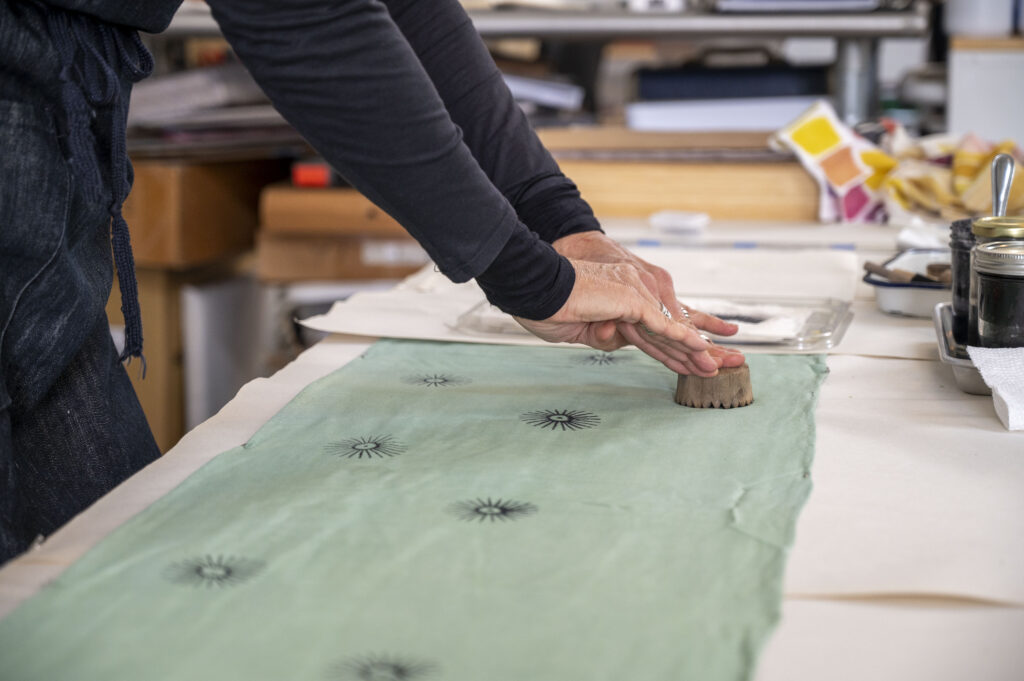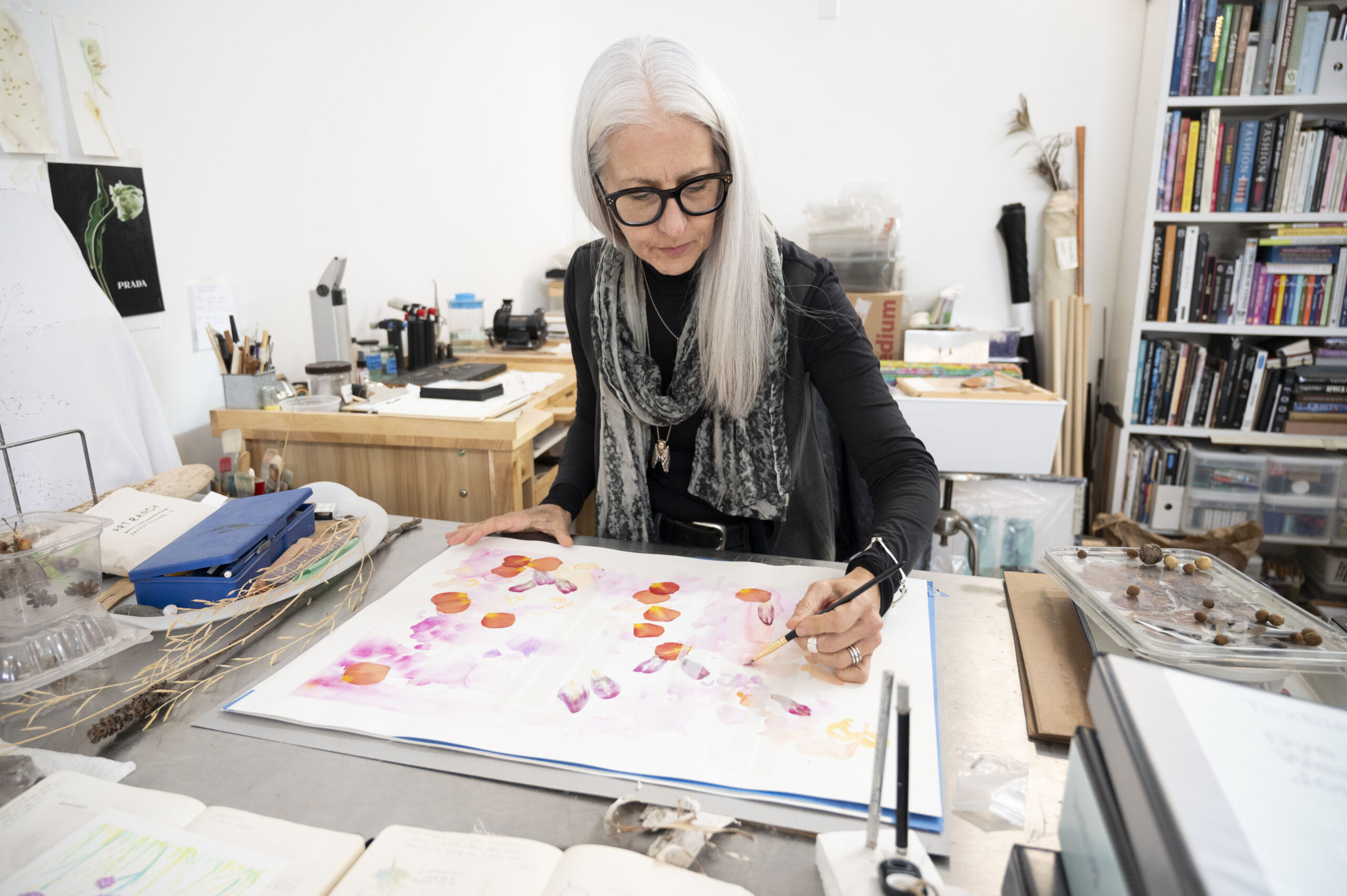Amy Tucker opens Art Ranch in Fredericksburg
By Megan Willome
The art Amy Tucker creates comes from her environment, on her ranch outside Fredericksburg.
She is like artists of old, making beauty from whatever is at hand. The final product she creates
may take many forms, but it begins with gathering leaves, flowers, bark, onion skins, eucalyptus,
even cochineal insects.
“It’s the only non-vegan item I used to make dyes. It makes a vibrant pink, and it’s a more
durable color because of the protein in the bug,” she said. “I like additive processes — growing
the plants, gathering the material, making the dye, testing it, making art.”
Tucker’s art encompasses assemblage, collage, jewelry, and often, textiles. She keeps a textile
log, where she records what natural dyes she used and where they were gathered, along with
notes on the process and samples.
“I’ll try anything,” she said. “I’m always wondering what would happen if I mix this with that?”
Tucker is from New York and moved to the Texas Hill Country full time in 2019. She went to
school at Skidmore College, then spent her career in fashion — working with Calvin Klein,
Coach, Liz Claiborne, Tumi, Sharif, and Swatch. She specialized in high-end leather goods. As
she moved up the corporate ladder, she thrived in an environment where she could apply her
analytical skills. But she missed creating.
“I wasn’t doing what I wanted to do to be thriving in my life,” Tucker said.
She had already started a jewelry collection, Black Swallow, but she wanted to explore other
mediums — textile art, fine art, art that experiments.
“I do paint, but I rip it up and cut it up. Or I paint a base and do things on it. I like putting things
together,” she said. “Everything I do is art. It may be wearable. It may be commercial. I want
people to be able to see things as both. I don’t define it. I’m dabbling in gray spaces.”
Tucker has loved clothes since she was a little girl and her doll, Betsy, had to go to a doll
hospital after having all her hair loved off. She filled the doll’s crib with dress-up clothes, and
her creativity with textiles took off.
“I began to see getting dressed each day as a way to create a visual statement. I love to create a
story with clothes,” she said.
Since clothes touch our skin, Tucker says it matters how they are made.
“Skin’s the biggest organ on the body. It can absorb chemicals in dyes or pesticides in cotton,”
she said.

All her dyes are natural and handmade. She gathers information about how to dye from historical
sources, including old Shaker texts and Native American writings. Her counters are covered with
plastic boxes containing flowers, leaves, bark — things that can become other things. Which is
how artists around the world have worked for centuries.
In her international travels with the fashion industry, she developed a passion for indigenous
crafts, noticing the throughlines that cut across cultures: shibori, from Japan; batik, from
Indonesia; resist dyeing techniques throughout Africa; tie-dye in the USA — they’re all similar
processes.
“Every culture has very similar types of crafts that inform the functionality and natural beauty of
everyday life. They’re all related, but different,” she said. “I really enjoy seeing that we are all
the same. The variety is driven by the cultural iconography, but also by the native plants and
minerals available to achieve those techniques.”
Once Tucker has created a piece of textile art, she has a knack for matching the piece with the
person.
“I had a professor who told me I ‘understood spatially.’ One of my strengths is being able to say,
‘This looks good on you because it has harmonious proportions,’” she said. “I don’t want to sell
to anyone what’s not right for them. I’m not a salesperson, but an aesthetics person.”
It’s important to Tucker that her textiles are made with a light environmental footprint. That
means using organic linens, cottons, and silks and also practicing what she calls “mindful
consumption.”
“I use all the plant I can and use it as much as I can,” she said.
Tucker loves to hike, to kayak, to forage. On her birthday, she invited artist friends for a week of
what she called “immersion and observation.” Each person received a gift of a paint kit, a
sketchbook, and a sealed tin to collect treasures, along with a printed guide inviting her friends to
observe the environment at different times of day, using all their senses.
She created the kind of experience she’d like to expand as she opens Art Ranch.
“It will be a creative space for people. We can do workshops. We can do experiences. We can do
artist residencies here. We just completed our artist casitas — each one is a small gallery,”
Tucker said. “The long-term plan is not just for me and my art, but all different kinds of artists,
including writers, poets, painters. They will come and see the environment in a new way.”
And that’s just the beginning of the type of artist collaboration Tucker hopes to foster.
“I’m looking to create an arts month in the Hill Country, involving different towns, to embrace
the creativity of the people here,” she said. “What can we do to work together as an artist
community? How can we reach more people? More age groups?”

Tucker has a history of bringing people together and empowering them. In 2021 she started
WIN, Women’s Innovation Network, connecting entrepreneurial women in the Texas Hill
Country. In 2024 programing will focus on issues of sustainability that impact the region.
Because in order to create art and encourage creativity in other artists, the land needs to be
healthy and vibrant. Tucker is working holistically, gathering people along with plants.
“All my art is inspired by nature,” she said. “I’m very intentional in everything I do.”

